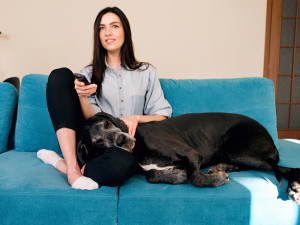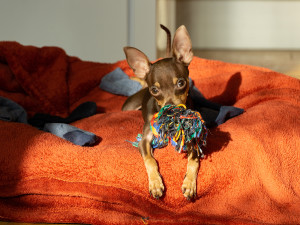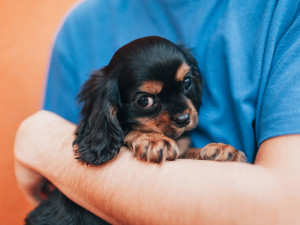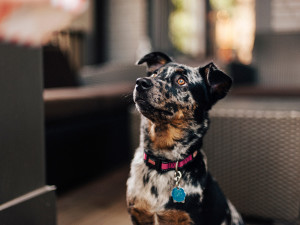Alexandra Horowitz, The Canine Mindseeker
What do dogs know and how do they know it?
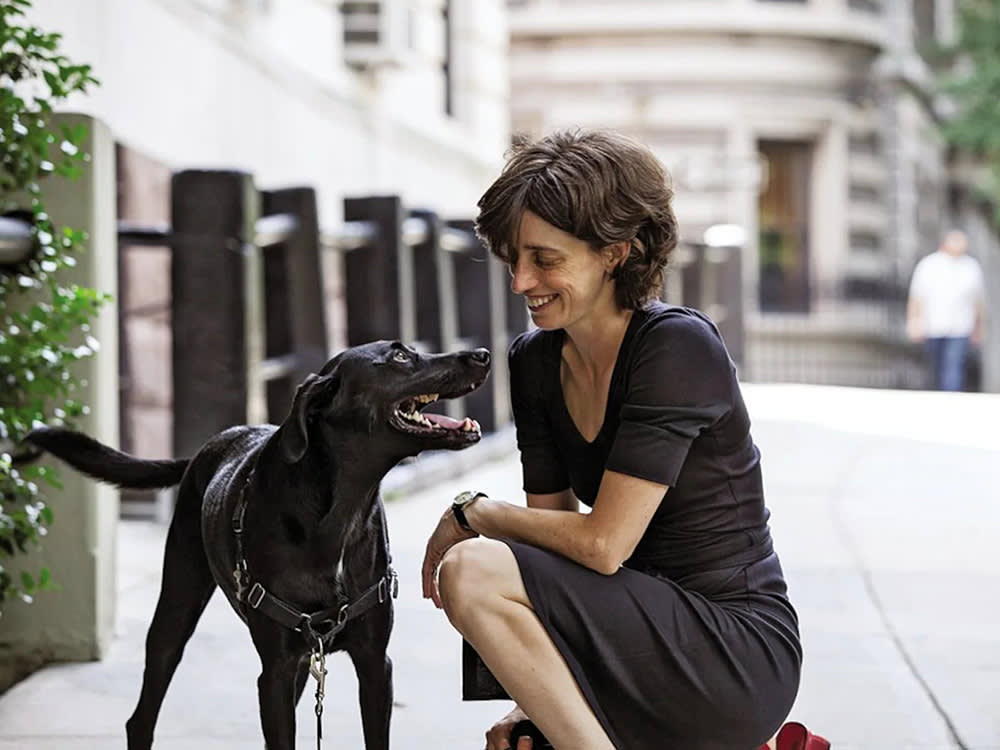
Share Article
Ever wanted to see and “smell” the world from your dog’s point of view? We talk with Alexandra Horowitz, a professor of psychology and canine cognition at Barnard College, Columbia University, who also leads the college’s Dog Cognition Lab, about her books on the study of dog behavior. Horowitz’s books Inside of a Dog: What Dogs See, Smell and Being a Dog: Following the Dog Into a World of Smell uncover new insights into the inner lives of dogs and their external behaviors. This article comprises two interviews originally published in The Bark magazine in 2009 and 2016.
The dog’s amazing olfactory powers make their worldview different than ours. Can you explain why?
As we go about our day, we see the world first, using vision to help make sense of the sounds (conversation, sudden honking, a nearby thud) and the smells (something rancid or sweet wafting on the air) around us. Dogs smell the world first, using olfaction to organize and make sense of what they see and hear. The richness of our visual world is matched, if not surpassed, by the richness of their olfactory world.
This leads to some profound differences in the way the world looks, which I describe at length in the book. For instance, smells deteriorate over long distances, and are carried hither and thither by currents of air. The visual scene does not change with the breeze, and with distance, only looks “more distant.” The result is that the world is mapped differently for the creature who primarily “sees” it via his nose rather than his eyes.
Has anyone studied why some dogs are better at smelling than others — is it genetic, or is it drive?
Everything I’ve seen points to drive being the major indicator of whether a dog will be good as a detection dog: drive to find the odor, to keep working when frustrated, to get to the reward (like a game with a tug toy) at the episode’s end.
This is not to say that breed is irrelevant: some breeds are naturally more driven to pursue an odor relentlessly, or are driven to do whatever it takes to get a game of toss with a tennis ball. And some dogs — like Bloodhounds and Beagles — have more olfactory cells in their noses and more equipment around their faces (long ears, drooly jowls) to help bring odors up the nose. They may smell odors at lower levels.

Curiously, though, the notion that certain breeds are inevitably better at detection work than others hasn’t been borne out. It’s tradition more than science.
Do working dogs get nose fatigue — do they reach a point at which they can no longer reliably follow a scent? If so, what do the pros do to work around that?
The phenomenon of the nose no longer noticing an odor — adaptation — happens to us within minutes. Walk into a coffee shop, take in its familiar odors and a few minutes later, you might smell…almost nothing. The receptor cells in the nose that noticed the odor simply stopped responding after continued exposure.
The cells in the dog’s nose work similarly, but any dog employed as a detection dog is doing something different. Because they continue to sniff different areas of the odor “scene,” their noses won’t turn off to the smell. Tracking dogs are also known to simply lift their noses from the ground once in a while and sniff the air, as though to clear their noses.
On the other hand, working dogs certainly get fatigued from too much stimulation and too much exertion. Handlers know their dogs and will read their dogs’ responses to know when they need a break.
In the book K9 Scent Training by Resi Gerritsen and Ruud Haak (leading specialists in identification, tracking and detection-dogs), I read that female dogs are better at smelling than males. Did this also come up in your research? Any idea if the same can be said for our species?
Gerritsen and Haak are great resources on detection-dog training and skills. I suspect their assessment comes directly from their own and other trainers’ experience with dogs. I don’t doubt it, though I don’t believe that the question has been formally tested. Interestingly, women are often said to be “better smellers” than men, and research does bear this out (on average, of course).
You note that dogs couldn’t really see TV in the pre-digital conversion days; the physiological reason behind this is significant — can you explain it?
It has to do with how we process light. Specialized cells in the eyes of mammals translate light waves into neural activity by changing the pigment in the cells. In the milliseconds that the pigment is changing, the cell can’t receive any more light. This leads to what is called the “flicker-fusion” rate: essentially, the number of snapshots of the world that the eyes can process each second. Our flicker-fusion rate is about 60 images per second.
The image on old TVs and film is really a sequence of still shots sent quickly enough to fool our eyes into seeing a continuous stream. Given our flicker-fusion rate, the film needs to be only slightly faster than 60 still images a second to trick our eyes into seeing motion. Dogs, though, have a faster flicker-fusion rate — about 70 or 80 stills per second. When watching film, they can actually detect the individual frames as well as the dark spaces between them. With the recent conversion to entirely digital television broadcasts, though, the flicker-fusion rate is no longer relevant, since digital TV works differently. So, in theory, dogs can watch TV — though it still is not very olfactorily interesting!
A lot of your research involves dog play. Why is play so important?
Play is a terrific venue in which to see dogs’ fast-paced, coordinated behavior; they are highly skilled players. As many dog owners may know, most bouts of play begin with a play signal, such as the familiar “play bow,” in which one dog bends down on his front legs, holding his rump high and his tail up and wagging. Another signal is the “exaggerated approach,” in which one dog lopes toward another dog, often with an extra-bouncy stride. These signals are considered requests to play, or announcements of an interest in playing. It appears to be important to play signal before starting to play, since play involves behavior that would be considered aggressive — biting, mounting, bumping — in another context.
When I looked at play sequences in very slow motion, what I was able to see was that dogs were very good at getting the attention of their hoped-for playmates before play signaling. And they seemed to know what kind of attention-getter would work in different situations: a more forceful attention-getter when the other dog is distracted, a mild one when the dog is standing idly. With humans, a person might need to shout to get the attention of someone talking to someone else; similarly, we don’t need to barge into someone standing right in front of us in order to get his attention. Dogs seem to know that. And then, only after getting the other dogs’ attention, did they signal an interest in playing.
Dogs of the same “breed type,” like herders, seem to enjoy playing together and appear to have different styles of play than other breed types. For instance, they use the “eye,” and play “who winks first gets to be chased.” Have you studied behavioral traits in breeds and how they are expressed during play?
I find it extremely interesting that breeds often gravitate to other members of their breed to play. Indeed, it seems that even similar-looking mixed-breeds often play together. Some of that could be explained by their owners’ interest in the familiar-looking or -acting dog (if owners loiter together, it gives the dogs more time to get acquainted). But most of it presumably comes from the dogs’ mutual recognition of characteristic behaviors in one another: the way the other dog solicits play, how he uses his tail and, as you suggest, even showing “eye” or other breed-typical behaviors. My own research did not control for breed, and I don’t know of any other studies that have specifically identified whether or not certain behaviors are more likely during play among members of one breed than play among members of another. It’s ripe for the investigating!
It was interesting that you said that long-time or close playmates can exchange shorthand signals with each other. How can we learn to read our dog’s shorthand?
The shorthand is usually a component of the play signal. The play bow involves bringing the forelegs down and the rump up — so, a shorthand version of that is what I call a “play slap”: just bending down on the front legs, usually with an audible slap. Similarly, many signals involve an open, almost grinning-looking mouth; as shorthand, a dog can do a very short open-mouth display with another dog. If you know the components of the signals, you can see how dogs break them up to use with their regular playmates.
How can you tell if your dog feels or is expressing guilt?
It is an open question whether dogs feel guilt, one that we all have our hunches about but that is very hard to confirm empirically. I recently published a study testing whether the “guilty look” that dogs show — ears back, tail down, slinking off or avoiding eye contact — actually indicates that the dog has disobeyed and possibly feels guilty. I found that dogs showed the most guilty look not when they had actually disobeyed, but rather, when they were scolded or confronted by a suspicious owner, even if they had done nothing wrong.
What most dogs do seem to know is that some actions — those that have provoked punishment in the past — are “wrong,” off-limits or at least likely to provoke punishment again. This is not the same as feeling guilt. They may do the guilty look as an entreaty not to be punished.
How can you tell if your dog is bored? I know that is one of the biggest concerns of pet parents.
Boredom in dogs looks remarkably similar, in broad strokes, to what it looks like in humans: flagging energy, reduced activity, poor attention, sleeping too much. Dogs may pace (similar to zoo animals kept in too-small enclosures with nothing to engage them) or do repetitive actions, such as licking or chewing themselves obsessively. If you come home to find your house in disarray, socks mauled, pillows disemboweled, it’s likely that your dog was bored — at least until he found those socks and pillows with which to occupy his time. Boredom can be sated by giving the dog something to do: play with him, give him plenty of social time with other dogs, or hide safe toys or treats for him to find when you’re away.
You said that “in many ways, dogs act as if they think about their memories as the personal story of their life.” What do you mean by this?
It is an intriguing question whether dogs think about themselves — that is, whether they have a sense of their own life story, their autobiography. It is also a very difficult question to address scientifically. I am proposing, however, that much of dogs’ behavior, such as what they remember — where they buried that bone last summer, the dog who was hostile the last time they met, a shortcut home — indicates that they are, in fact, thinking about their life in an autobiographical way.
Besides enrolling our dogs in nosework classes, what do you recommend that pet parents do to tap into their world of smell and enrich their lives?
Let them smell. If you live with a dog, start thinking about what the world is like from an olfactory point of view. Let them smell you (you are your scent, to your dog), let them smell each other (that’s how they find out who it is), and let them smell the world. Take walks for smelling (not just for peeing, or for exercise). The pleasure that comes from watching a dog snuffling down a path, nose to the ground and nose in the air, guided by nothing more than the filaments of odors that come his way, is to me unmatched.

Claudia Kawczynska
Claudia Kawczynska was co-founder and editor-in-chief of The Bark for 20 years. She also edited the best-selling anthology Dog Is My Co-Pilot.
Related articles
![Woman in vintage striped pants walking in park while her pet is following the trail. Cute beagle dog sniffs something on the path in morning.]()
Does Your Dog Have a Nose For Scent Training?
This sounds like a competition show waiting to happen.
![Dark brown dog sitting on a gray couch in a living room]()
Turns Out Dogs Can Tell, Er, Smell Time
There’s no time like the present, according to your pet.
![A man in a blue t-shirt holding a super cute puppy against an orange background]()
Baby Face: The Allure of Cute Dogs
The evolutionary advantage of Kindchenschema for animals.
Do Dogs Understand Our Words?
Say What? A look at the types of words that dogs understand.
